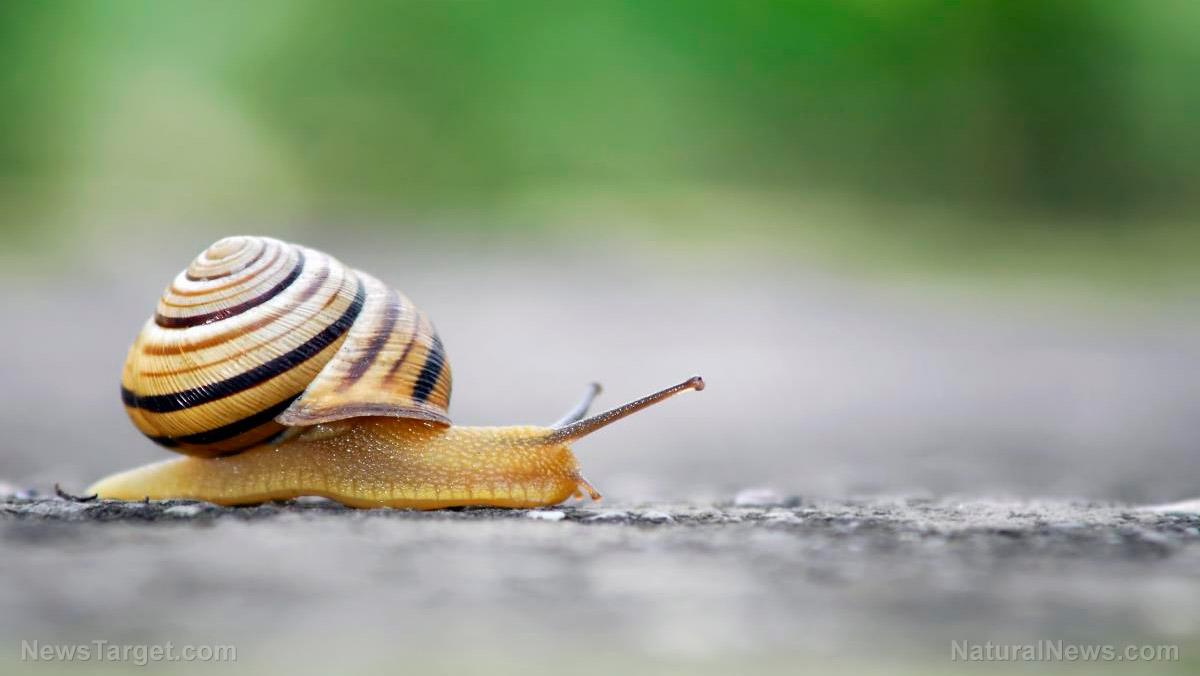
Slugs and snails might be the last thing you want for dinner, but you can't afford to be picky when your supplies are running out in a post-SHTF world. (h/t to PreppersWill.com)
People in countries like France, Portugal and Spain consider escargot, or cooked snails, as a delicacy, but the average American might have second thoughts about this unusual dish.
Escargot is French for snail and this snail dish is often served exclusively at French restaurants. Depending on how you cook them, snails are fairly nutritious since they are high in protein and low in fat.
Escargot is usually served as an appetizer or main entree. Traditionally, French-style cooked snails are served with parsley and garlic butter. The snails are then served hot and you get them out of their shell before eating.
What are gastropods?
Shelled gastropod mollusks live in the oceans, in freshwater and on land. Those that have lost their gills and breathe air are the easiest to identify.
Snails and slugs (or a snail without a shell) are high in nutrients, particularly protein and numerous minerals. Mollusks are relatively easy to find if the environment is damp, making them an accessible food source.
Slugs and snails are nocturnal, meaning it's best to hunt them at night. (Related: Food supply 101: Fish, a cheap and easy survival food.)
Slugs
Slugs are gastropod mollusks with no shells. Many slug species are generally regarded as being shell-less, but they actually have a reduced internal shell.
The two common slug groups are round backs and keeled slugs. Slugs in the round back group have dome-shaped bodies, like the common garden slug.
Keeled slugs have a ridge, or keel, running along their back. The keeled slugs are the larger slug and they can reach up to seven or nine inches in length when fully stretched out.
Slugs use the retractable tentacles on their head to smell and detect food up to several meters away. Slugs are black, rubbery-like creatures covered in sticky mucus and live mainly in leaf litter.
Slugs have a rasp-like radula or tongue and chitinized jaw that they use to eat succulent plants. They can also eat carrion and fungi.
Snails
Snails are slugs with shells that are made from calcium and form a spiral column in which the snail lives. Unlike the sausage-shaped slug, the snail’s body has a bag-like structure.
The visible part of a snail is the foot, with the head at one end identified by the two retractable tentacles. Like slugs, snails secrete mucus that is used to lubricate the surface over which it is moving.
When dry, the mucus forms silver-colored lines that you can often see in the morning.
Snails also have a rasping radula tongue that they use to eat tender young plants. While essentially vegetarian, some snails are carnivorous and can feed on earthworms and other snails.
Collecting slugs and snails
To catch slugs and snails, look in damp areas or dew-laden grass early in the morning.
Both slugs and snails avoid dry, hot areas and are usually more active during the evening. To be safe, only collect slugs and snails which are alive.
Generally, snails are nocturnal and sleep during the day. The mucus they secrete seals their shell, preventing the snail from drying out.
You can also eat hibernating snails, but you have to check if the seal around the shell entrance is intact and not receding. If you collect snails with receding seals, you have to discard them because they are either dead or on their last day of life.
Safety tips when collecting slugs and snails
Only collect slugs and snails in areas free of poisonous plants or fungi. Snails, especially slugs, can process the toxins ingested from eating poisonous plants and fungi for their own benefit.
Depending on the plant, cooking the slugs and snails won't always break down the toxins to make them safe to eat. This is why you have to properly purge their stomachs for at least 24 hours before cooking.
Since slugs are more prone to eating poisonous plants or fungi than snails, people tend to avoid them in favor of snails.
Purging
Purging helps remove body waste and the remains of toxic plants from the stomach so the slugs or snails are safe to eat.
To purge slugs or snails, soak them in salty water for at least 24 hours. If you don't have salt, place them in a container with harmless plants or vegetables. As they eat the plants, they will excrete what's in their stomach.
If you can forage for something like wild garlic or another strong herb feed them this. Garlic or herbs will also infuse into the slug or snail's flesh and help improve their taste.
Alternatively, you can feed them breadcrumbs or bran as these will help absorb any toxin present, which is then excreted. Never eat slugs or snails raw.
How to cook slugs and snails
Traditionally, snails are boiled, but you can also cook them in the embers of a fire. Another option is to fry them in garlic butter.
Cook snails for about eight minutes. If you are boiling them, don't place too many in the pot at the same time. As snails get hotter, the water will begin to froth because of the slime released from the body.
Enhance the taste by adding a spice or strong herbs, like wild garlic or mint, to the water. While the foot itself may be a little rubbery, the rest of the snail should be soft and tender.
You can also cook snails by wrapping them in edible leaves with a few herbs and a drop of water. Cover the leaf with wet mud and cook in the fire’s coals for 10 to 15 minutes, depending on how many snails you have and how big they are.
Because the snails will cook in their own juices, they don't lose the "meaty" taste you lose with boiling. You can also try this method by cooking them in aluminum foil.
Snails you forage in the wilderness will be smaller than the large white snail (Helix pomatia) often eaten in France.
When SHTF and you run out of food, forage for slugs and snails. Clean and prepare them properly if you need nutritious survival food.
Watch the video below to know how to forage for hickory nuts.
This video is from the SHTFPrepping101 channel on Brighteon.com.
More related stories:
Food supply tips: 9 Ways to preserve meat at home.
Food prep and storage tips for your emergency food supply.
Food supply 101: Tips for preparing a healthy food stockpile.
Sources include:
Please contact us for more information.























